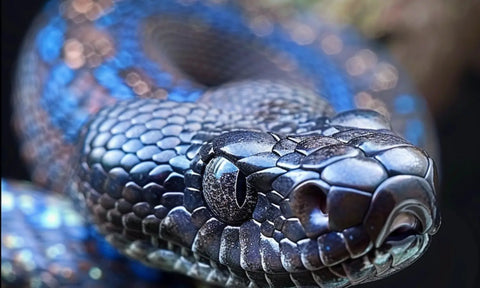Snake facts you should know!
Snakes are elongated, limbless reptiles of the suborder Serpentes Like all other squamates, snakes are ectothermic, amniote vertebrates covered in overlapping scales
There are approximately 25 species of snakes living in Canada. The group is divided into 30 distinct families and many subfamilies, making it the second largest reptile group after lizards.
What are 10 facts about snakes?
No eyelids: Snakes don't have eyelids. Instead, they have a thin, transparent membrane called a "brille" that protects their eyes.
Forked tongue for tasting and smelling: Snakes use their forked tongue to taste and smell their surroundings. They flick their tongues out to collect particles in the air, which are then analyzed by a special organ called the Jacobson's organ.
Flexible jaws: Snakes have incredibly flexible jaws that allow them to swallow prey much larger than their heads. They can dislocate their jawbones to accommodate their meal.
Shedding skin: Snakes shed their skin regularly to grow and replace damaged scales. This process is called "ecdysis."
Ancient creatures: Snakes have been around for millions of years. Fossil evidence suggests that snakes evolved from lizards.
Variety of sizes: Snakes come in a wide range of sizes, from the tiny thread snake to the massive anaconda.
Venomous and non-venomous: Some snakes are venomous, meaning they inject venom into their prey through fangs. Others are non-venomous and rely on constriction or crushing to kill their prey.
Nocturnal and diurnal: Some snakes are primarily active during the day (diurnal), while others are most active at night (nocturnal).
Different habitats: Snakes can be found in a variety of habitats, including forests, grasslands, deserts, and even aquatic environments.
Diverse diets: Snakes eat a wide variety of prey, including insects, rodents, birds, other snakes, and even fish.
While the common belief is that snakes are "solar-powered" and require outside heat, the term "cold-blooded" is often used to describe reptiles, even though this is not entirely accurate as their blood is not actually cold.

The proper term to use for these animals is "ectothermic", meaning that their body temperature fluctuates and relies on external sources for regulation. However, there are some exceptions to this definition. Some larger reptile species, including pythons, can generate heat by shivering.
What are some dark facts about snakes?
Unlike endotherms like mammals and birds who can internally regulate their body temperature, most reptiles rely on sources like the sun to stay warm. It's crucial for ectothermic creatures to maintain warmth as their bodily functions and metabolic processes, such as digestion and movement, depend on external heat for optimal functioning and activity levels.
Elevate your style with our stunning snake rings – shop now!

Despite what you learned in school, not all snakes lay eggs. Reptiles are different from mammals because they lay eggs. However, many snake species give birth to already-developed young (viviparous). Embryos can even develop in eggs that hatch in the uterus before being born fully formed (ovoviviparous) in some species!
Because snakes lack eyelids, they can't blink and must sleep with their eyes open. Instead of eyelids, they have thin membranes attached to their eyes to protect them. This membrane is called a lunette.
What special abilities do snakes have?
Snakes possess a range of special abilities that make them highly adapted and successful predators. Here are some of the most notable abilities:
1. Infrared Vision (Heat-Sensing Pits)
-
Pit vipers, boas, and pythons have specialized heat-sensing organs called pit organs located between their eyes and nostrils. These organs detect infrared radiation (heat) from warm-blooded prey, allowing them to "see" in the dark and accurately strike even in complete darkness.
2. Flexible Jaw and Skull Structure
- Snakes have highly flexible jaws and skulls that can stretch and dislocate, allowing them to swallow prey much larger than their head. Their lower jaw is not fused at the chin, enabling them to open their mouths extremely wide. This adaptation is crucial for consuming large prey whole.
3. Venom Delivery System
- Many snakes possess a sophisticated venom delivery system, which includes venom glands and hollow or grooved fangs. The venom can be a mix of neurotoxins, hemotoxins, and cytotoxins, which can immobilize prey, begin the digestive process, or defend against predators.
4. Locomotion Techniques
-
Serpentine Movement: The most common form of snake movement, where the snake moves in an S-shaped curve.
-
Sidewinding: Used by desert-dwelling snakes like the sidewinder rattlesnake to move efficiently on loose sand.
-
Rectilinear Movement: Large snakes like pythons and boas use this method, moving in a straight line by contracting their belly muscles.
-
Concertina Movement: Used in confined spaces, where the snake anchors part of its body and pulls the rest forward.
5. Camouflage and Coloration
- Snakes often have skin patterns and colors that allow them to blend seamlessly into their environment. This camouflage helps them avoid predators and sneak up on prey. Some species can even change their skin color to better match their surroundings, like the chameleon-like ability seen in certain pit vipers.
6. Shedding (Ecdysis)
- Snakes shed their skin periodically to grow and remove parasites. This process, known as ecdysis, allows them to maintain a healthy outer layer. The shedding also enables them to escape predators, as the skin can tear away if grabbed.
7. Chemoreception (Jacobson's Organ)
- Snakes use their forked tongues to pick up chemical cues from the environment and deliver them to the Jacobson's organ in the roof of their mouth. This organ helps them "taste" the air, detect prey, and identify potential mates or threats.
8. Brumation
- Similar to hibernation, brumation is a state of dormancy that snakes enter in cold weather. During this period, their metabolism slows down dramatically, allowing them to survive long periods without food and in harsh conditions.
9. Autotomy (Tail Shedding)
- Some snakes, particularly those in the colubrid family, can shed their tail as a defense mechanism when threatened by predators. The tail continues to wriggle, distracting the predator and allowing the snake to escape.
10. Vibrational Sensitivity
- Snakes lack external ears but are highly sensitive to vibrations. They can detect ground vibrations through their jawbones, which helps them sense approaching predators or prey even from a distance. This sensitivity also allows them to navigate their environment effectively
What is a surprising fact?
A surprising fact about snakes is that some species can fly—or at least glide through the air. The **Chrysopelea** genus, commonly known as the **flying snake**, is native to Southeast Asia. These snakes are capable of gliding between trees by flattening their bodies and launching themselves into the air.
By undulating their bodies in an S-shape while airborne, they can glide for distances up to 100 feet (30 meters). Despite not having wings or any other specialized limbs for flight, these snakes can maneuver surprisingly well in the air, making them one of the most unusual and unexpected examples of animal locomotion.

Snakes have nostrils, but they don't use them to smell. Instead, they use their tongues, using the Jacobson's organ in their roofs. Snakes have a bifid tongue and numerous receptors capable of picking up different quantities of chemical signals, as if they were smelling "in stereo". Therefore, snakes have a very good sense of smell.
In contrast to us, snakes have a different table manner. Since they can't chew, snakes swallow their food whole since they can't chew. Snakes have a highly flexible lower jaw, which allows them to swallow animals 75% to 100% larger than their heads. Once food is ingested, chemical compounds in their digestive tract perform all the work of digesting it.
What is the biggest snake facts?
Here are some of the most remarkable and "biggest" facts about snakes:
1. Largest Snake Ever Recorded
- The reticulated python (Malayopython reticulatus) holds the title for the longest snake in the world. The longest recorded individual measured 32 feet (9.75 meters) in length. These pythons are found in Southeast Asia and are known for their incredible size and strength.
2. Heaviest Snake
- The green anaconda (Eunectes murinus), found in South America, is the heaviest snake in the world. While it may not be as long as the reticulated python, it can weigh up to 550 pounds (250 kilograms). Their girth and muscle mass make them formidable predators, capable of taking down large prey like caimans and deer.
3. Longest Venomous Snake
- The king cobra (Ophiophagus hannah) is the longest venomous snake in the world, capable of reaching lengths of up to 18 feet (5.5 meters). Despite its size, the king cobra is incredibly agile and can deliver a lethal dose of venom in a single bite.
4. Longest Lifespan
- Snakes can live for several decades, with some species in captivity reaching 30 to 40 years. The ball python (Python regius), for example, has been known to live over 40 years in captivity. In the wild, their lifespan tends to be shorter due to environmental challenges.
5. Largest Snake Egg
- The Burmese python (Python bivittatus) lays some of the largest snake eggs, with a single egg being as long as 5 inches (13 cm). A female can lay up to 100 eggs in a single clutch, which she then incubates by coiling around them and shivering to generate heat.
6. Most Venomous Snake
- The inland taipan (Oxyuranus microlepidotus), also known as the "fierce snake," is considered the most venomous snake in the world. A single bite contains enough venom to kill 100 adult humans. Despite its lethal potency, it is reclusive and rarely encountered by humans.
7. Longest Fangs
- The Gaboon viper (Bitis gabonica) has the longest fangs of any snake, measuring up to 2 inches (5 cm) long. These fangs allow it to inject large amounts of venom deep into its prey, making it an efficient predator.
8. Largest Prey Consumed
- Some large constrictor snakes, like the Burmese python and green anaconda, have been known to consume prey as large as adult deer, capybaras, and even small crocodiles. These snakes can expand their jaws and stretch their skin to swallow prey much larger than their head.
9. Fastest Striking Speed
- The black mamba (Dendroaspis polylepis) is one of the fastest-striking snakes, capable of delivering multiple bites in rapid succession, sometimes within milliseconds. Its speed, combined with potent venom, makes it one of the most dangerous snakes in the world.
10. Biggest Snake Venom Yield
- The Gaboon viper also holds the record for the largest venom yield of any snake. In a single bite, it can deliver up to 2 grams of venom, which is enough to kill several adult humans or a large animal.
Elevate your style with our stunning snake rings – shop now!

Consider the various ways snakes can move. Picture a snake slithering across the grass. Which image comes to mind? Perhaps the well-known S-shaped motion, also referred to as lateral undulation, which is easily identifiable as a snake's primary mode of movement. However, snakes possess four other forms of locomotion.
What's a fun fact about snakes?
A fun fact about snakes is that some of them are surprisingly good swimmers! Sea snakes, for instance, spend almost their entire lives in the ocean and can hold their breath for up to 2 hours underwater. They have specialized flattened tails that act like paddles, allowing them to swim efficiently. Even land-dwelling snakes like anacondas and cottonmouths are excellent swimmers and can navigate through water with ease.
So, despite their reputation as land-dwellers, many snakes are quite at home in aquatic environments, making them versatile and adaptable creatures.
For instance, tree snakes utilize a method known as concertina, which requires significantly more energy than lateral undulation - about seven times more, in fact. This technique involves bending the body into distinct curves and then straightening it alternately. Moreover, when attempting to escape from a smooth surface, snakes have a specific movement at their disposal: the push-slide.

Sentient snakes think, feel, and have unique personalities.
Recent studies are beginning to challenge the concept that self-recognition is a human ability and not shared by dolphins, chimpanzees, or elephants.
It has been shown in the scientific journal Behaviour that garter snakes (Thamnophis sirtalis) recognize their own chemical signals as distinct from those of other snakes.
In addition to escaping predators, hunting prey, finding a mate, orienting themselves in their habitat, snakes use chemical signals to identify their own chemical signature.
Elevate your style with our stunning snake rings – shop now!

According to a study published in the Journal of Behavioural Ecology and Sociobiology, snakes aren't solitary animals at all. According to the study, the garter snake (Thamnophis sirtalis sirtalis sirtalis) not only seeks out social interactions, but prefers to be associated with specific individuals or groups as well! There are a number of reasons why snakes seek out these "friendships" (warmth, protection), but this study proves that they have a higher level of social intelligence than most of us realize.
At Snake Label® we want to honor these magnificent but often misunderstood reptiles. We want to change the negative view of snakes held by most people. Our passion for these animals shines through in our snake-themed clothing, jewelry and accessories.
Dive into the fascinating world of snakes and explore our other articles now!
Stay Updated!
Don't miss out on the latest insights, tips, and exclusive content. Subscribe to our blog newsletter today and be the first to know about new posts, special offers, and more!
Join our community now—just enter your email below to stay connected.